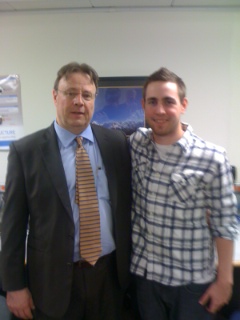It was not in the MTP business plan for 2011, but over the past several months I have been speaking to College and University students about getting jobs and careers after college. After 28+ years in “sales” public speaking is something that I take for granted. I love it – I look forward to it – give me a microphone and a laser pointer and I am one happy camper.
This past week I had the pleasure of speaking to the students at Quinnipiac University. This was an extra special day, as my son Tom Jr. is a Senior at Quinnipiac, in the School of Business - Computer Information Systems.
My first presentation was to my son’s Systems Analysis and Design class. It is a little daunting to present to a room full of people who are half your age and possess twice your IQ.
Next up was to the entire School of Business. It was a standing room only crowd, and the students were receptive and very attentive. I might not be smarter than the students, but I am still bigger.
Not too many years ago, a College or University was judged by its library. “He who has the best library wins”. In fact, that specific asset (the library) is what forced students to physically attend that institution of higher learning in the first place – that is where all the books are located. No books, no learning. No learning, no education. No education, no advancement. And then, no American Dream.
Technology has broken down the barriers of entry to reaching the American Dream.
If you really want to learn something, you can do so. Now. Right now, from your home. Just as only a few years ago, a College or University would be judged by the size of its library – they would be judged by the number of books and periodicals in the rows and rows of “stacks”. Today the academic criteria and asset judgment is a “wired campus”. Global distance learning, cloud computing, high speed mobile broadband, VoIP and other unified communication technologies of the past ten years have let the proverbial genie out of the bottle for higher education.
When founded in 1901, United States Steel Corporation was the largest business enterprise ever launched, with an authorized capitalization of $1.4 billion. Throughout the years, U. S. Steel responded to changing economic conditions and new market opportunities through diversification and periodic restructuring. Today, over a century after its founding, U. S. Steel remains the largest integrated steel producer in the United States.
In the film The Godfather Part II, Hyman Roth tells Michael Corleone "Michael, we're bigger than U.S. Steel". If I referenced that movie quote to my college student audiences, they would have no idea what I was taking about. In fact, some of the younger professors in the room would not know what I was talking about either!
Times change, and it is technology that drives that change.
So, here is what I learned in college this week:
The best days of this country are ahead of us. I know this to be true – I can see it in the faces of the students. The hard assets of this country might have shifted; but the most important assets are still there: passion, energy and a thirst for knowledge.
Just as the USA was once known for U.S. Steel, and once known for its manufacturing muscle and other “hard” assets, the USA will soon be known for a different kind of manufacturing. It will be the manufacture of innovation and change. Just as colleges and universities were once known for their physical libraries and massive cavernous lector halls, technology will continue to change everything. Especially in higher education.
The USA will be judged by its ongoing creation of (and open collaboration of) ideas, the production of thought leadership and global creativity through education. The job descriptions of teachers and educators will change, and the techniques and technologies of global distance learning will continue to morph and adapt to a global marketplace. Global distance learning screams out that “none of us are as smart as all of us”.
That quote is indeed stronger than steel.


Thanks Tom (and "Tommy boy"!!!)
ReplyDelete